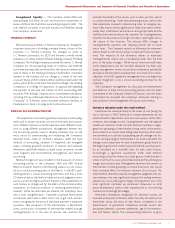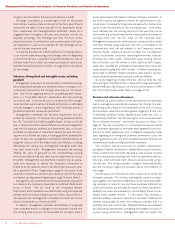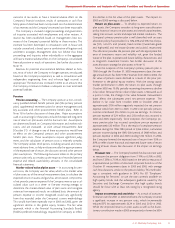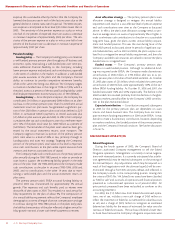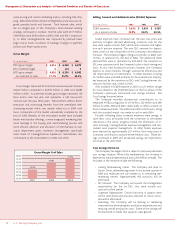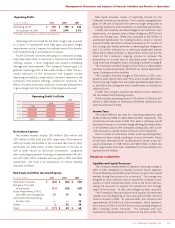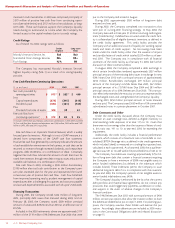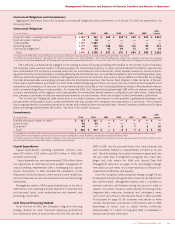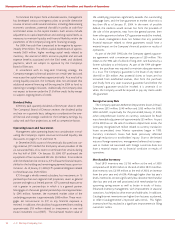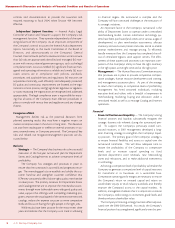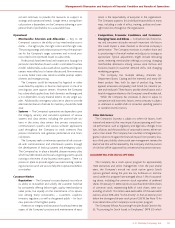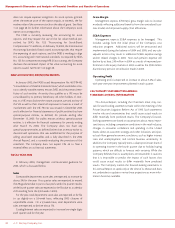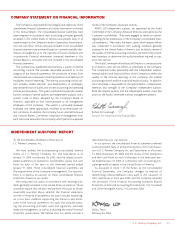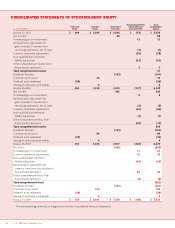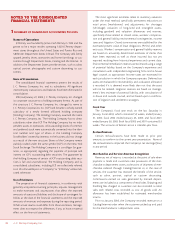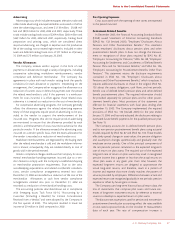JCPenney 2003 Annual Report Download - page 19
Download and view the complete annual report
Please find page 19 of the 2003 JCPenney annual report below. You can navigate through the pages in the report by either clicking on the pages listed below, or by using the keyword search tool below to find specific information within the annual report.
J. C. Penney Company, Inc. 17
Management’s Discussion and Analysis of Financial Condition and Results of Operations
Debt Percent to Total Capital
The Company manages its capital structure to ensure financial
flexibility and access to capital, at a competitive cost, necessary to
accomplish its business strategies. Management considers all on-
and off-balance sheet debt in evaluating the Company’s overall
liquidity position and capital structure. Off-balance sheet debt
consists of the present value of operating leases (PVOL), which
are a fundamental part of the Company’s store operations.
While the debt percent to total capital, including off-balance
sheet debt, is not intended to be a substitute for the comparable
GAAP measure, management believes that this approach is a
more comprehensive and realistic view of financial leverage. Debt
investors and the credit rating agencies also consider off-balance
sheet debt when evaluating financial leverage.
Debt Percent to Total Capital
($ in millions) 2003 2002 2001
Short-term investments(1) $(2,986) $(2,468) $ (2,834)
Short-term debt 18 13 15
Long-term debt(2) 5,356 5,173 6,060
Net debt 2,388 2,718 3,241
PVOL(3) 657 659 794
Tot al debt , including
PVOL 3,045 3,377 4,035
Consolidated equity 5,425 6,370 6,129
Tot al capital(4) $8,470 $9,747 $ 10,164
Debt percent to total capital 30.6% 29.9% 34.6%
Debt percent to total capital,
including PVOL 36.0% 34.6% 39.7%
(1) Includes restricted balances of $87 million, $86 million and $114 million in 2003,
2002 and 2001, respectively.
(2) Includes current maturities, capital leases and other.
(3) PVOL is the estimated present value of operating leases.
(4) Eckerd PVOL of $3.3 billion, $2.9 billion and $2.8 billion for 2003, 2002 and 2001,
respectively, and securitization of receivables of approximately $200 million each year,
have been excluded for all periods presented due to being reported as a discontinued
operation.
The Company’s capital structure in 2003 was positively impact-
ed by improved earnings, which contributed to the approximate-
ly $379 million of positive free cash flow generated from continu-
ing operations. Overall, however, the 2003 debt percent to total
capital increased slightly due to the reduction to equity of $1.3 bil-
lion to reflect Eckerd at fair value and the related tax effect of a
potential sale transaction, as discussed in Note 2.
As the Company proceeds with the divestiture of its drugstore
operations, proceeds from such a transaction will be used to fur-
ther strengthen the Company’s financial position and capital
structure. Through an appropriate mix of both common stock
repurchases and long-term debt retirements, management will
seek to deliver value to the Company’s shareholders and support
the long-term objective of improving the Company’s bond cred-
it ratings. Going forward, the Company’s financing strategy will
remain focused on preserving both strong liquidity and financial
flexibility as management works to improve the performance of
both Department Stores and the Catalog/Internet operation.
See discussion of financing transactions on page 14.
RISK MANAGEMENT
Management recognizes its responsibility to proactively man-
age risks effectively in order to maximize enterprise value (defined
as the combined market value of the Company’s debt and equity)
to investors. A certain degree of risk is inherent in operating a
three-channel retailing organization. The Company has an
enterprise-wide risk management framework in place to identify,
measure and manage risks. The Company’s organizational struc-
ture, both at the Board and Company management levels, plays
a critical role in maintaining an effective overall risk management
process, as highlighted by the following risk management and
monitoring processes:
Independent Oversight — There are various committees at
the Board of Directors’ level that oversee the risk governance
activities of the senior management committees. The Audit
Committee of the Board of Directors is responsible for discussion
of guidelines and policies to govern the process by which risk
assessment and management is undertaken. In addition, the
Audit Committee reviews with management the system of inter-
nal controls and financial reporting that is relied upon to provide
reasonable assurance of compliance with the Company’s opera-
tional risk management processes. The Finance Committee of
the Board of Directors reviews the Company’s overall financing
plan and dividend policy, as well as the liquidity position of the
Company, discussed below. The Human Resources and
Compensation Committee of the Board of Directors oversees
senior management committees responsible for retirement and
welfare plans, equity and other compensation plans.
Executive Management Committee — Sets the overall
strategic direction and financial targets for the Company, defines
the enterprise-wide risk tolerance levels consistent with overall
business strategies, recommends capital and operating budgets
to the Board of Directors, and is responsible for managing the
portfolio of risks throughout the enterprise.
•The Finance Liquidity Team, under the oversight of the
Executive Committee, monitors the Company’s liquidity
and cash flows as they relate to operating performance,
inventory and working capital requirements, capital
expenditures, financing and compliance with debt and bank
covenants.
Capital Appropriations Committee — Reviews and approves
individual capital and systems projects and ensures proper capital
allocation consistent with the overall capital expenditure plan.
Disclosure and Controls Review Committee (DCRC) and
Sarbanes-Oxley (SOX) Steering Committee — The DCRC is
made up of senior executives of the Company, including the
CEO. The DCRC ensures that the Company’s established disclo-
sure controls and certification process are adhered to. The SOX
Steering Committee oversees the implementation of the
corporate control procedures of Section 404 of the Sarbanes-
Oxley Act (Section 404) to ensure that the Company has proper


